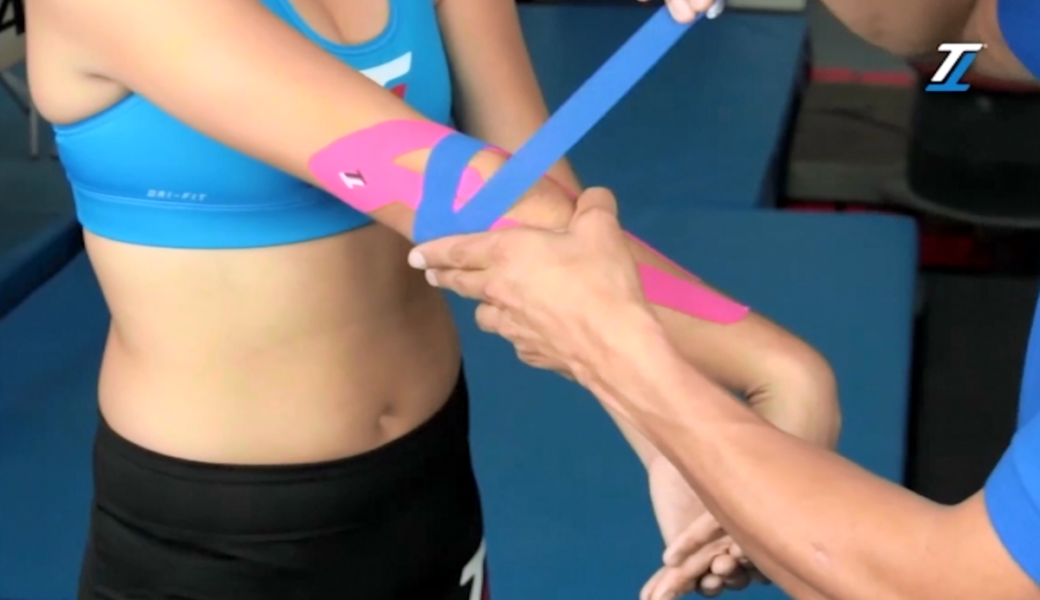Kinesiology tape is used when an individual experiences pain in a tendon or body part. Until recently, many athletes who suffered a torn tendon were forced to end their careers, however, with SpiderTech’s new kinesiology tape, athletes can simply tape their kinesiology tendon tears with kinesiology tape.
In recent years, you might have noticed that athletes from all over the world have been donning brightly coloured tape all over their bodies for sporting events. This tape is not just a flashy fashion statement, but it actually serves a purpose. It’s called kinesiology tape and it was invented in the 1970s by a Japanese chiropractor named Dr. Kenzo Kase. Dr. Kase wanted to find a treatment that allowed a patient’s natural healing processes to occur but, at the same time, be flexible enough to move with the body. Thus, the conception of kinesiology tape.
What Is Kinesiology Tape?
Kinesiology tape is characterized by its elasticity and other qualities that mimic our skin. It is breathable, water-resistant and allows moisture to wick away. The glue found on kinesiology tape is heat-activated and applied in a wave-like texture to mimic a fingerprint and allow the tape to stay on longer. The tape is designed for use during exercise and movement, and you can even go swimming with it on. Today there are over 50 kinesiology tape brands and products on the market, with more being added every single day.
What Kinesiology Tape Isn’t
Kinesiology tape does not contain any drugs or medication in its construction. Even though it can be found in many different colours, the colour of the tape has no bearing on its effectiveness and does not indicate any difference between tapes. All tapes, irrespective of their colour, have the same elasticity and perform in the same manner.
Many athletes around the world have been seen using kinesiology tape during big sporting events, like marathons. Athletes tout that the kinesiology tape helps them to prevent injury and enhance their performance. The kinesiology tape is placed on the body strategically, in order to provide support, lessen pain, reduce swelling and improve performance.
While kinesiology tape has a lot of athletic fans, it also has gained popularity among the medical field as well. Its design and application is the reason why it has gained popularity within the physiotherapy world. Many physiotherapists have expressed that they have seen patients in their clinics who have incredible healing experiences with using kinesiology tape.
There is a growing body of clinical research involving kinesiology tape that supports that it has positive effects on the body. Although, there are a lot of conflicting conclusions, so it is possible for people to pick and choose whatever works for their argument. That being said, research has been found:
- To improve the power and strength in patients who have injured muscles.
- Improve pain, range of motion and function in people with impingements.
- Reduce pain and improve function in painful conditions.
And much more.
How Exactly Does Kinesiology Tape Work?
While there might not be a whole lot of research on kinesiology tape and its function, there is a theory behind how kinesiology tape works.
The kinesiology tape, once applied, causes a decompression between your skin and your tissue underneath it. This helps to facilitate three main things: promotion of blood and lymphatic flow, muscle stabilization, and reducing pain.
The fluid effect of kinesiology tapes happens because the tape causes a lifting of the skin from the underlying tissue. This space is known as the subcutaneous space and it contains things like nerve endings and blood vessels. This decompression then promotes the flow of blood and lymphatic fluids in and out of the area that is taped. This helps your body to remove old fluids and other pain inducing chemicals and promotes your body’s healing processes.
The mechanical effect of kinesiology tape is due to its stretch properties. The tape contains longitudinal stretch properties of 140-180% and is similar to the properties found in your skin, muscles and connective tissues. The tape adds another layer of stability and awareness to muscles, ligaments, joints, etc.
Lastly, kinesiology tape has a neurological effect and by that we mean an actual effect on the way your nervous system responds to it. The presence of the tape on your skin helps to create a non-painful stimulus in the area. This causes your nervous system to be unable to feel pain in the area, or a reduction of pain. Because the tape has such great decompression properties, this reduces the pressure and the compression on your nerve endings, causing them to fire fewer pain signals to your brain. If the tape is applied to extremely tight muscles, it will help alleviate this tightness, causing them to feel less tight and sore for the patient. If the tape is applied over weak, sore or injured tissues, it will act like an aid to the body’s healing process in that it alters the activity and feedback from your nerves and tissue.
Who Can Use Kinesiology Tape?
Kinesiology tape can be used by anyone at any age, from children to the elderly. And it can be used in a lot of applications to help any pain or dysfunction in your body’s musculoskeletal system. Anyone can use kinesiology tape, provided they have some guidance and maybe a second pair of hands to reach some areas. But once learned, application is easy. Even though the glue found on the tape is tough and durable, it can be removed easily, with little discomfort and leaves almost no residue on your skin. Additionally, the glue and tape itself contains no latex, so those people who are allergic to most other types of tapes are able to use it.
Some Disadvantages Of Kinesiology Tape
- Kinesiology tape can very rarely cause an irritation or allergic reaction in the skin for some individuals. In these cases, it is best to have it removed immediately and explore other treatment options.
- If the tape is applied incorrectly with too much tension on the ends of the tape, it can also cause irritation and result in inflammation.
- Kinesiology tape on its own is not a miracle cure and should not be used as the only treatment solution for specific patients and ailments. Rather, it should be used in conjunction with other treatment types for it to be most effective.
For these reasons and more, kinesiology tape has been a popular treatment option for physiotherapists, osteopaths, chiropractors and other health professionals in a similar field. It’s recommended that you have a health professional help you with your first applications of the tape so that they can show you how to use it properly.
As with any other injuries and treatment options, you should seek the advice of a medical professional before trying anything on your own to manage your injury or pain.
Severe injuries or chronic problems need the help of other treatment options alongside the use of kinesiology tape. But if you have mild to moderate pain, no major swelling or bruising, or no major loss in your movement of strength and you would like to use kinesiology tape, you can get yourself a roll and try it on yourself. There won’t be any serious negative side effects other than slight discomfort if you’ve applied it wrong. But there are many instructional video tutorials provided out there on the internet that you can watch.
Again, if you are experiencing pain that is not going away, seek the advice of a medical professional!
Author’s bio
Rhett Desormeaux is a content writer currently working with BreezeMaxWeb. He’s a passionate writer and loves studying ancient history, especially Bronze Age civilizations.












